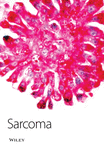Phase II Study of Ifosfamide+Doxorubicin in Patients With Advanced Synovial Sarcomas (E1793): A Trial of the Eastern Cooperative Oncology Group
Abstract
Purpose Because we had observed in the synovial sarcoma subgroup of a broad phase III advanced soft tissue sarcoma study a significantly greater objective regression rate from ifosfamide+doxorubicin (88%) than from doxorubicin alone (20%) (P = 0.02), the Eastern Cooperative Oncology Group (ECOG) decided to further assess this two drug combination in a subsequent Phase II study.
Patients Between 1994 and 1999, twelve adult patients with advanced synovial sarcomas were enrolled to receive, as their initial chemotherapy, ifosfamide 7.5 gm/m2 plus doxorubicin 60 mg/m2, given intravenously over two consecutive days every 3 weeks.
Methods Each day for 2 days doxorubicin 30 mg/m2 was infused over 5 min through a running i.v., followed by ifosfamide 3750 mg/m2 over 4 h. Continuous i.v. fluid was infused at 300 mL/h for 3 h on day 1, before chemotherapy was begun; then the infusion was continued at 100 mL/h for a total of 3 days. Mesna 750 mg/m2 was given 15 min before ifosfamide and at 4 and 8 h after ifosfamide on days 1 and 2 of each treatment cycle. Filgrastim (G-CSF) 5 μg/kg was given subcutaneously each day for 14 days beginning on day 3 of each treatment cycle to limit the severity of neutropenia.
Results Five of our 12 patients (42%) experienced partial regression of their advanced synovial sarcomas; however, this first stage result was borderline for proceeding to the second planned stage of accrual and our case accrual was quite poor. Thus, the study was closed after stage one accrual. Our patients received a median of four cycles of chemotherapy (range: 1 to 6). All patients experienced at least grade 3 neutropenia (grade 4 in nine of them), and one patient died of treatment-related sepsis following the initial cycle of chemotherapy. Median survival was 11 months.




